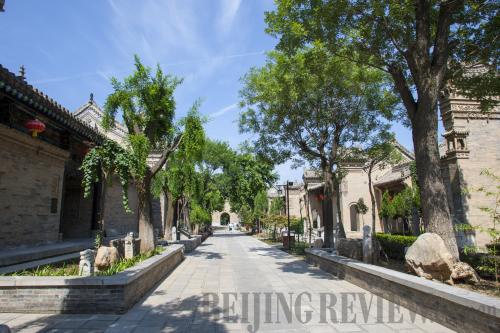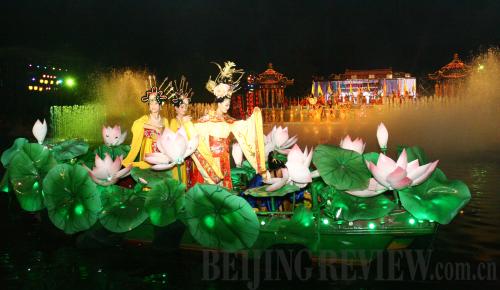|
 |
|
EXPERIENCE THE HISTORY: The Guanzhong Folk Art Museum is comprised of 40 ancient residences of the Ming and Qing dynasties (ZOU YI) |
Guanzhong Folk Art Museum
In the autumn of 1985, building contractor Wang Yongchao participated in a project involving the maintenance of ancient structures. This was his first chance to visit the hinterland of Shaanxi Province in northwest China. He soon developed an interest in collecting cultural relics, including delicate stone engravings and sculptures, brick carvings, hitching posts, woodblock prints, shadow puppets, old furniture, as well as wooden windows and doors with carvings. With the idea of saving and collecting as much as possible, Wang set up the Guanzhong Folk Art Museum, which was opened to the public in December 2008.
The outdoor museum, covering 33 hectares of land in the center of Qinling Zhongnanshan Global Geopark, houses some 40 ancient residences of the Ming (1368-1644) and Qing (1644-1911) dynasties. Every single brick of the 20 courtyards was numbered so that they could be reconstructed if damaged or torn down. Another 20 courtyards were rebuilt by imitating the Ming and Qing designs. The courtyards are all neatly lined up.
Another magnificent scene is some 8,600 hitching posts with vivid stone carvings and figurines on top. These hitching posts mainly date from the Tang Dynasty (618-907) until the Qing Dynasty.
Visitors can also enjoy a local opera called Laoqiang, which has been sung for more than 1,000 years. The performance is short, only about 10 minutes, but very impressive, and the performers are all local farmers.
- The admission fee is 120 yuan ($20). To get there, take Bus 500 from the Xi'an Railway Station to the Guanzhong Folk Art Museum stop.
Huashan Mountain
Situated in Huayin City, Huashan Mountain is 120 km from Xi'an and is famous for its steep and narrow paths and precipitous crags. It has five peaks. The east peak is the best place to enjoy a sunrise; the south peak has the highest altitude; the west peak is the most breathtaking; the north peak pierces the clouds and the middle peak is named Jade Lady Peak, based on a story of a woman who rode a white horse through the mountain.
If climbing is not your cup of tea, ride a cable car. The cable car to the north peak takes seven or eight minutes at 1.5 km in distance. The other cable car to the west peak is about 4.2 km away and takes roughly 20 minutes.
- The entrance fee to Huashan Mountain is 180 yuan ($29) from March to November and 100 yuan ($16) from December to February.
 |
|
OPERA TIME: The Song of Everlasting Sorrow is performed on the Nine-Dragon Lake in Xi'an (CFP) |
Drama: The Song of Everlasting Sorrow
Huaqing Hot Springs used to be the place where Emperor Xuanzong of the Tang Dynasty and Yang Yuhuan, his favorite concubine, bathed. The setting is the scene for the moving but sorrowful love story between the two, written into a long narrative poem called The Song of Everlasting Sorrow by Bai Juyi (772-846), a famous realist poet of the Tang Dynasty. Now the poem has been adapted to a large-scale historical drama presented in the evening at the Huaqing Hot Springs.
Set at Lishan Mountain, the drama is presented on the Nine-Dragon Lake surrounded by pavilions, corridors, palaces and willows. Sound and lighting techniques and the deftly designed stage achieve the right blend of history and realism, nature and culture to deliver a magnificent and genuine feel, with both a fabricated and outdoor setting intertwined.
- The performance runs from April to October and begins at 8:30 p.m. To get there, take buses 306, 914 or 915 from the Xi'an Railway Station. Since the performance ends late, no public transport will be available to return to the city. Tourists can share a private taxi or stay at a nearby hotel or guesthouse. Even during the peak season, securing accommodations shouldn't be a problem. Ticket prices range from 218 yuan ($36) to 988 yuan ($161). Try to book with a travel agent for a possible discount.
| 